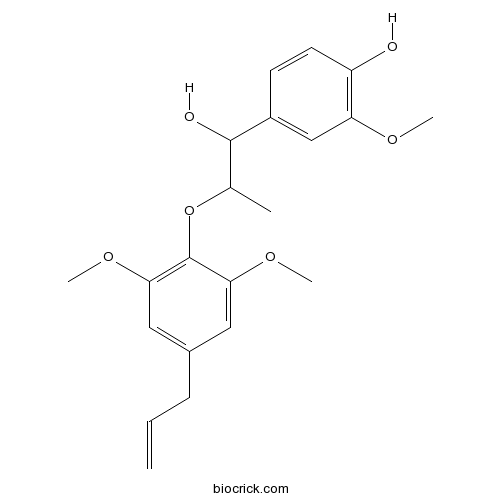1-(3,4-dimethoxyphenyl)-2-(4-allly-2,6-dimethoxyphenoxy)propan-1-olCAS# 41535-95-9 |

- Myrislignan
Catalog No.:BCN1242
CAS No.:171485-39-5
- cis-Myrislignan
Catalog No.:BCX1556
CAS No.:52190-21-3
Quality Control & MSDS
3D structure
Package In Stock
Number of papers citing our products

| Cas No. | 41535-95-9 | SDF | Download SDF |
| PubChem ID | 23872112 | Appearance | Powder |
| Formula | C21H26O6 | M.Wt | 374.4 |
| Type of Compound | Phenylpropanoids | Storage | Desiccate at -20°C |
| Solubility | Soluble in Chloroform,Dichloromethane,Ethyl Acetate,DMSO,Acetone,etc. | ||
| Chemical Name | 4-[2-(2,6-dimethoxy-4-prop-2-enylphenoxy)-1-hydroxypropyl]-2-methoxyphenol | ||
| SMILES | CC(C(C1=CC(=C(C=C1)O)OC)O)OC2=C(C=C(C=C2OC)CC=C)OC | ||
| Standard InChIKey | ULZFTGWWPHYLGI-UHFFFAOYSA-N | ||
| General tips | For obtaining a higher solubility , please warm the tube at 37 ℃ and shake it in the ultrasonic bath for a while.Stock solution can be stored below -20℃ for several months. We recommend that you prepare and use the solution on the same day. However, if the test schedule requires, the stock solutions can be prepared in advance, and the stock solution must be sealed and stored below -20℃. In general, the stock solution can be kept for several months. Before use, we recommend that you leave the vial at room temperature for at least an hour before opening it. |
||
| About Packaging | 1. The packaging of the product may be reversed during transportation, cause the high purity compounds to adhere to the neck or cap of the vial.Take the vail out of its packaging and shake gently until the compounds fall to the bottom of the vial. 2. For liquid products, please centrifuge at 500xg to gather the liquid to the bottom of the vial. 3. Try to avoid loss or contamination during the experiment. |
||
| Shipping Condition | Packaging according to customer requirements(5mg, 10mg, 20mg and more). Ship via FedEx, DHL, UPS, EMS or other couriers with RT, or blue ice upon request. | ||
| Description | 1. 1-(3,4-Dimethoxyphenyl)-2-(4-allly-2,6-dimethoxyphenoxy)propan-1-ol shows anti-staphylococcal activity against a total of five multidrug-resistant (MDR) and methicillin-resistant Staphylococcus aureus strains and the minimum inhibitory concentrations (MICs) are in the range of 128-256 ug/ml. |

1-(3,4-dimethoxyphenyl)-2-(4-allly-2,6-dimethoxyphenoxy)propan-1-ol Dilution Calculator

1-(3,4-dimethoxyphenyl)-2-(4-allly-2,6-dimethoxyphenoxy)propan-1-ol Molarity Calculator
| 1 mg | 5 mg | 10 mg | 20 mg | 25 mg | |
| 1 mM | 2.6709 mL | 13.3547 mL | 26.7094 mL | 53.4188 mL | 66.7735 mL |
| 5 mM | 0.5342 mL | 2.6709 mL | 5.3419 mL | 10.6838 mL | 13.3547 mL |
| 10 mM | 0.2671 mL | 1.3355 mL | 2.6709 mL | 5.3419 mL | 6.6774 mL |
| 50 mM | 0.0534 mL | 0.2671 mL | 0.5342 mL | 1.0684 mL | 1.3355 mL |
| 100 mM | 0.0267 mL | 0.1335 mL | 0.2671 mL | 0.5342 mL | 0.6677 mL |
| * Note: If you are in the process of experiment, it's necessary to make the dilution ratios of the samples. The dilution data above is only for reference. Normally, it's can get a better solubility within lower of Concentrations. | |||||

Calcutta University

University of Minnesota

University of Maryland School of Medicine

University of Illinois at Chicago

The Ohio State University

University of Zurich

Harvard University

Colorado State University

Auburn University

Yale University

Worcester Polytechnic Institute

Washington State University

Stanford University

University of Leipzig

Universidade da Beira Interior

The Institute of Cancer Research

Heidelberg University

University of Amsterdam

University of Auckland

TsingHua University

The University of Michigan

Miami University

DRURY University

Jilin University

Fudan University

Wuhan University

Sun Yat-sen University

Universite de Paris

Deemed University

Auckland University

The University of Tokyo

Korea University
- 2,6,16-Kauranetriol
Catalog No.:BCN5472
CAS No.:41530-90-9
- Koaburaside monomethyl ether
Catalog No.:BCN5471
CAS No.:41514-64-1
- Daturaolone
Catalog No.:BCN3904
CAS No.:41498-80-0
- 12-Oleanene-3,6-diol
Catalog No.:BCN3903
CAS No.:41498-79-7
- 3-Amino-1-phenyl-2-pyrazolin-5-one
Catalog No.:BCC8605
CAS No.:4149-06-8
- Belinostat (PXD101)
Catalog No.:BCC2153
CAS No.:414864-00-9
- Turkesterone
Catalog No.:BCN2363
CAS No.:41451-87-0
- Bruceantin
Catalog No.:BCN7618
CAS No.:41451-75-6
- Onetine
Catalog No.:BCN2102
CAS No.:41451-67-6
- Phalaenopsine Is
Catalog No.:BCN2016
CAS No.:41451-64-3
- (+)-N-Methylallosedridine
Catalog No.:BCN5470
CAS No.:41447-16-9
- (-)-N-Methylsedridine
Catalog No.:BCN5469
CAS No.:41447-15-8
- N6-Cyclopentyladenosine
Catalog No.:BCC7160
CAS No.:41552-82-3
- SN-6
Catalog No.:BCC7273
CAS No.:415697-08-4
- RI-1
Catalog No.:BCC1896
CAS No.:415713-60-9
- Poricoic acid G
Catalog No.:BCN8267
CAS No.:415724-84-4
- Carboplatin
Catalog No.:BCC1170
CAS No.:41575-94-4
- 4,R-ajmalicine N-oxide
Catalog No.:BCN5473
CAS No.:41590-29-8
- (-)-Pinoresinol 4-O-glucoside
Catalog No.:BCN7251
CAS No.:41607-20-9
- Ylangenol
Catalog No.:BCN6705
CAS No.:41610-69-9
- Ciclopirox ethanolamine
Catalog No.:BCC4372
CAS No.:41621-49-2
- Lacinilene C
Catalog No.:BCN5474
CAS No.:41653-72-9
- Koaburaside
Catalog No.:BCN5475
CAS No.:41653-73-0
- 7-O-Methyl morroniside
Catalog No.:BCN3882
CAS No.:41679-97-4
Diphenylpropanoids from Quisqualis indica Linn. and their Anti-staphylococcal Activity.
LATIN AMERICAN JOURNAL OF PHARMACY 28(2):279 · January 2009
Four diphenylpropanoids- 1-(4-hydroxy-3-methoxyphenyl)-2-(4-allyl-2,6-dimethoxyphenoxy) propan-1-ol (1), 1-(3,4-dimethoxyphenyl)-2-(4-allyl-2,6-dimethoxyphenoxy)propan-1-ol (2), 1-(3,4- dimethoxyphenyl)-2-(4-allyl-2,6-dimethoxyphenoxy)propan-1-ylacetate (3) and 1-(4-hydroxy-3,5- dimethoxyphenyl)-2-(4-allyl-2,6-dimethoxyphenoxy) propan-1-ol (4) were isolated from the chloroform soluble fraction of a methanol extract of Quisqualis indica. The structures of these compounds were established unambiguously by MS and a series of 1D and 2D-NMR analyses. All compounds were tested for their anti-staphylococcal activity against a total of five multidrug-resistant (MDR) and methicillin-resistant Staphylococcus aureus strains and the minimum inhibitory concentrations (MICs) were in the range of 128-256 μg/ml.


